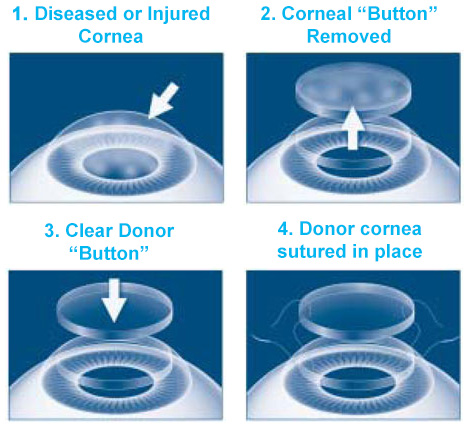Cornea Transplant / Keratoplasty
The cornea is the only structure of the eye that can be successfully transplanted for visual restoration. Currently, cornea transplant has undergone may advances and involves layer by layer transplants, which have highly increased the success chances of this operation.
In this procedure, the blood of the deceased donor is first screened for transmissible diseases like HIV/HCV etc. After this the donor cornea undergoes a “Specular Microscopy” which is a test to analyse the health of the cells of the donated cornea tissue. Based on the result, the donors can be divided for various uses.
A THERAPEUTIC KERATOPLASTY is a type of cornea transplant that is performed for patients with massive cornea infections which have not come under control with drops, or which have potential to spread deeper and damage the entire eye.

In this procedure, the diseased cornea is replaced with a donor cornea for the purpose of only controlling the corneal infection. The patient may require a second surgery for visual correction.
OPTICAL KERATOPLASTY is a corneal transplant that is solely done for the visual function of the patient.
Cornea transplants can further be divided into full-thickness or Partial-thickness (LAMELLAR) surgery. This is based on the layer of the cornea that is damaged and replaced.
In full thickness or Penetrating Keratoplasty, the entire diseased cornea is removed and replaced with donor tissue of full thickness of the corneal button.
LAMELLAR surgeries are advanced surgeries, where only the damaged tissue is replaced. i.e. either only the front of the cornea or the back of the cornea. This basically means that one donor cornea can be used for 2 different surgeries and help 2 individuals gain sight !
DALK- Deep Anterior Lamellar Keratoplasty is a cornea transplant surgery that involves removing only the front damaged layers of the cornea and the back remains the patients own layer.
DSEK- Descemet’s Stripping Endothelial Keratoplasty is a cornea transplant surgery where only the last damaged layer of the eye is replaced, the front layers are the patient’s own.
The cornea transplant cost is higher for lamellar surgery because of the surgeon skill and equipment used to get better results. These surgeries are preferred since they reduce chances of cornea rejection after transplant surgery.
Dr Kareeshma Wadia has done a super speciality in this field and spent 2 years in Bangalore at Narayana Nethralaya Superspeciality Eye Hospital to master the art of these cornea transplant surgeries.
We cannot emphasize more on the need to donate your eyes, and not bury/burn them. Eye donation can be done within 6 hours after the death of a person. All you need to do is contact your nearest eye bank/ the hospital in which the death has occurred and they will do the needful.

Cornea Transplant / Keratoplasty FAQs
In any organ transplant, there is always the risk of rejection, this can be reversed with eye drops most of the time.
Certain instructions provided by the doctor must be followed they are as follows: • During the first few weeks’ post-surgery avoid heavy exercises or heavy lifting. • Do not rub your eyes • Avoid places or activities which have or can produce dust as that could cause irritation to the eyes. • Avoid contact sports and swimming, at least until your doctor says it is safe for you. • You will be prescribed eye drops post-surgery which you must continue to put for the prescribed duration as it will help in reducing the inflammation.
You will be prescribed eye drops and ointments to reduce swelling prevent infection and also prevent the chances of rejection. Depending on the type of operation that you have undergone, you may or may not have to have stitches removed. The doctor will recommend that you wear glasses or other protective eyewear for some time.
Jehan Eye Clinic is a center for skilled clinical excellence, and aims at being at par with the latest technology at all times. It is headed by Dr Kareeshma Wadia-Havewala, who is a specialist in Cataract, Cornea and Refractive Surgeries.
Quick Links
Contacts
- 302, D-Square, Dadabhai Road,Opp. C.N.M. School, Vile Parle West,Mumbai - 400056.
- +91 7045658586
- jehaneyeclinic@gmail.com
